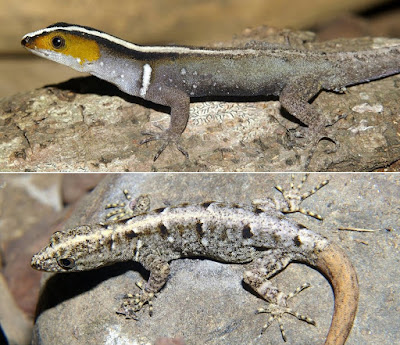Abstract
Gonatodes rayito sp. nov. is described from the western versant of the Cordillera de Mérida, Venezuela. Like most species of Gonatodes the new species is sexually dichromatic and is one of only a few in the genus in which individuals have a conspicuous, pale middorsal stripe. The new species is similar to, and has been confused in the past with, G. petersi and G. vittatus. It differs from both species in several aspects of color pattern, and also from G. vittatus in size and scale counts. The validity of Gonatodes rayito sp. nov. is also strongly supported by a phylogenetic analysis using a fragment of the ornithine decarboxylase nuclear gene.
Keywords: Gonatodes rayito sp. nov., Gonatodes petersi, Gonatodes vittatus, lizard, gecko, Gekkota, taxonomy, Reptilia, Squamata, Sphaerodactylidae
 |
| Male Gonatodes rayito sp. nov. (MCNG 2231, holotype); Female Gonatodes rayito sp. nov. (MCNG 2237)
photos: Juan E. García-Pérez
|
Gonatodes rayito sp. nov.
Gonatodes petersi Donoso-Barros: Esqueda (2004) [two specimens, ULABG 4726, 4741, from near Santa Apolonia, Mérida,
Venezuela]
Gonatodes vittatus (Lichtenstein): Rivas et al. (2006) [in part, specimens from Mérida]
Gonatodes v. vittatus (Lichtenstein): Rivero-Blanco (1967) [specimens of G. v. vittatus reported in sympatry with G. albogularis
in “Sur del Lago” are likely G. rayito based on locality. The two live specimens of G. v. vittatus pictured from “La Azulita”
are also G. rayito]
Etymology. The specific name is the Spanish word meaning “little lightning” or “little ray”, a name informally coined by the late naturalist Dr. Richard Schargel for individuals of this species as well as of G. petersi and G. vittatus. The name refers to the notion that, because males of this group of species have a conspicuous middorsal white stripe, when they flee they resemble a “little white lightning.” Richard kept many species of Gonatodes in captivity and also helped support the first author on his research on the genus.
Walter E. Schargel, Gilson A. Rivas, Juan E. García-Pérez, Carlos Rivero-Blanco, Paul T. Chippindale and Matthew K. Fujita. 2017. A New Species of Gonatodes (Squamata: Sphaerodactylidae) from the western versant of the Cordillera de Mérida, Venezuela.
Zootaxa. 4291(3); 549–562. DOI: 10.11646/zootaxa.4291.3.7
Resumen: Gonatodes rayito sp. nov. es descrita de la vertiente oeste de la Cordillera de Mérida, Venezuela. Al igual que la mayoría de las especies de Gonatodes, la nueva especie es sexualmente dicromática y es una de las pocas en el género en que los individuos poseen una línea vertebral clara conspicua. La nueva especie es similar a, y ha sido confundida en el pasado con, G. petersi y G. vittatus. Se diferencia de ambas especies en varios aspectos en el patrón de la coloración, y también de G. vittatus en el tamaño y en conteo de escamas. La validez de Gonatodes rayito sp. nov. es también corroborada por un análisis filogenético en el que se usó un fragmento de un gen nuclear (ODC, por sus siglas en inglés).



